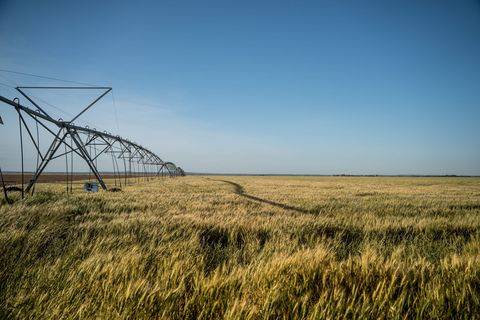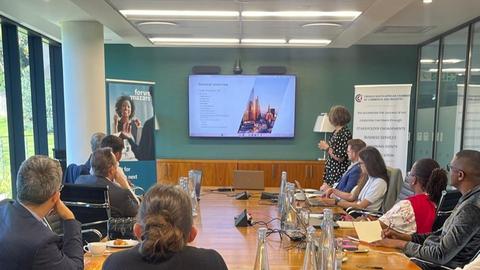Event report • Committees • Sectors & markets Agriculture - Agroalimentaire
Back To | 'Water & Irrigation Challenges in South Africa' – Agri Committee Workshop

For its first workshop, FSACCI Agri Committee chose to address the topic of ‘Water & Irrigation Challenges in SA’s Agriculture & Agribusiness Sector'
Three experts in the field landed their expertise on the topic, as reported below:
SOME INTRODUCTORY QUESTIONS
Dr Damien Jourdain
Researcher, CIRAD (Agricultural Research for Development)
- 65% of South Africa’s territory receives less than 500mm/y in average annual rainfall which is the limit for successful ‘dryland cultivation of crops’
- Agriculture & Irrigation represent 61% of South Africa’s water demand (in line with global average),
- Municipal and domestic use of water represents 27%: high to due to lot of waste in the systems.
- Irrigation is very important to the agricultural sector as it accounts for 30% of the country’s crops
- The agricultural and agro-industrial sectors contribute to a combined 15% of the GDP, are key to the food industry and job creation opportunities
- 98% of the available water is already allocated
This puts pressure on the ‘ecological reserve’ which is the minimum amount of water to keep for the ecosystem to remain functional. With population increase and need to feed this increasing population, with no doubt, demand will grow up in the future. - Risks of shortfall are high and already taking place in some places (e.g., Cape Town 2018)
- Yet SA Government targets an increase of irrigated areas by 50% (NDP’s Vision 2030)
- Pollution creates issue in terms of water quality
Two way-outs: increase supply (re-use, groundwater, desalination) and/or reduce demand (reduce loss and consumption from municipalities, increase agriculture efficiency, improve irrigation practices). Cooperation private-public is key.
Three open questions:
Can changes in water pricing work as an incentive to use less? Water is having a price, do we pay the right price for water in SA?
E.g., large price increase, large investment, ‘water rent’, subsidies for new equipment, better controls
With increased irrigated areas, how to provide water access to small holders/emerging farmers?
E.g., reallocations, less crop per drop, trainings for increased efficiency
What about the use of ‘alternative’ water by agriculture?
E.g., re-used water, desalinated water, information
Additions & Comments
- The municipality water load is a key issue that needs to be solved but it is also very political
That share also includes the private consumption of water (pools, gardening, etc.) which requires further education on the impact and risks - Water is a common good in South Africa (no private ownership) meaning that the political dimension about ownership of the land doesn’t come into play when it comes to water – Gov. is the custodian of water resources and central to its management
- The 60% water use figure regarding agriculture is to be contextualised – Agriculture uses what remains after municipalities and industries have taken their share
- We shouldn’t oppose Farmers and Consumers. CoVID 19 helped a lot to make the population aware of importance of Agriculture. Both Farmers and Consumers should work on “saving” water. Education and awareness are key.
- It is important to note that South Africa is the only African country that is theoretically food secure (remarkable in a water scarce country) which highly contributes to the social stability of the country
The sector’s contribution to the country is far more important than the 20% GDP figure but water scarcity put food security at risks. - Unlike France or Europe, agriculture receives no or very little government support (yet providing food security with limited resources)
CHALLENGES IN IRRIGATION AGRICULTURE IN SOUTH AFRICA
Lourens Janse Van Rensburg
Regional Manager Sub-Saharan Africa, Lindsay Africa
- South Africa has 35,000 commercial farmers (=95% agricultural outputs)
+ 4,000,000 small scale farmers (=75% of SA’s farming operations) (2019)
Only 4% of farms have a turnover of more than R5 million (2018) - SA agriculture must deal with issues around water, electricity, land which create market uncertainty
The development and use of new technologies is key - The use of water in South Africa revolves around 3 main issues: its availability, rights, and quality
- Small farmer integration requires fundings, the uptake of technology, trainings, mentorship, capacity building, private sector investment
- 80% of farmers over irrigate on their farms
- Technology enables to produce more efficiently by optimising the use of water and the timing of application (e.g., use of crop models according to the rainfall, precision irrigation)
It reduces the input costs, maximises the outputs for a minimum environmental impact. Innovation is already proposing pivot with no electricity.
IMPACT OF CLIMATE CHANGE ON AGRICULTURE IN WESTERN CAPE & ADAPTATION STRATEGIES
Dr Tara Southey
Centre for Geographical Analysis at the University of Stellenbosch
- The last 5 years in Western Cape have been the hottest in 138 years, creating increased seasonal variability, with previsions for further increases in temperatures in the coming years
- Understanding the changes in climates in various South African regions is key to identifying the right crop types and reaching a better efficiency in water use
- Months/regions are being impacted differently which influences crop responses and water demand
These shifts and changes (temperatures, rainfalls, soil salinity, seasons, etc.) make the access and use of technologies more important than ever to make informed agricultural decisions - Issues of data accessibility, integrity, and distribution in terms of weather stations need to be urgently addressed
- Mindsets also need to shift to allow for more efficient water irrigation systems based on spatial decision support systems (for long and short-term decisions) which ingest multiple climate and terrain datasets into maps helping with infield management
- TerraClim webapp (www.terraclim.co.za) presents high temporal and spatial resolution maps of climatic and geographical datasets to obtain pertinent information on climate, terrain, and soils
(Includes both public and restricted data access)
Additions & Comments
- There is an important issue around small holder farmers’ access to water
- Small farmers are not easily accessible/reachable yet these messages about water usage and new technologies need to be communicated to them specifically
- Weather based insurance?
- Tara’s presentation has been very local, but it is also very concrete and shows how climate change can impact locally farming, for instance change in cycle (planting-harvest), in crops.
- This presentation shows also that farmers should adapt to changes (cost, skills, information), and no matter their sizes.
- Commercial farmers, emerging farmers or small farmers should not be opposed. There is a need to invite organization of farmers to make them aware of the new technologies.
CONCLUSION
- Agriculture is key to South Africa’s economy and stability as a country
- Water scarcity puts pressure on food security in South Africa – be it from consumer or farmer usage
- Information is key, especially for small farmers, as many water saving technologies already exist
- Both small scale and commercial farmers are to the agricultural sector and need technology development and support
- There is a significant need for training and skills
- Cooperation between the public and private sector is key
Nothing can be done without government support












